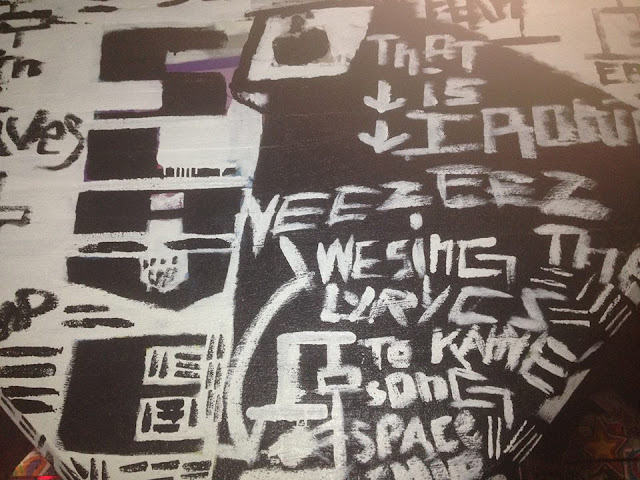The Ever-Changing Graffiti of the Krog Street Tunnel
 Built in 1912, the Krog Street Tunnel in Atlanta is a vital artery for pedestrians, cyclists and vehicular traffic. But that's not all. The interior of the tunnel itself is a chaotic collage of graffiti art and something else to behold.
Built in 1912, the Krog Street Tunnel in Atlanta is a vital artery for pedestrians, cyclists and vehicular traffic. But that's not all. The interior of the tunnel itself is a chaotic collage of graffiti art and something else to behold.
It's a living breathing organism of ever changing graffiti. Some of it so layered, and evolved, that it almost resembles one of those old Basquiat paintings from the 1980s. Walls, pillions, the strip lighted roof, the mucky floor, potholed and puddled, nothing is spared the cheeky tag of the graffiti artist's brush and spray-can.
And this street art, some of it good, some of it bad, some political, some personal (like marriage proposals), some meaningless, some not, is tolerated, and encouraged, by the powers-that-be. In other words, it's okay to get out a spray-can and add your own scrawl or stencil to the continually evolving canvas of the Krog Street tunnel. It's pretty much mandatory.







First constructed in 1912, and completed in 1913, the Krog Street Tunnel runs under the Halsey Yard and has two lanes for traffic and pedestrian walkways. Because the tunnel runs between DeKalb Avenue on the Inman Park end and Wylie Street on the Cabbagetown bit, the city is keen to incorporate it into "the Atlanta BeltLine Eastside Trail" extension. The extraordinary graffiti art in the tunnel, however, will go on. It's tradition. Some locals recall seeing art in the tunnel as far back as fifty years ago. But it wasn't until the beginning of this century, when the hood became more gentrified, that the locals began to finally embrace the vandal's scrawl, and made this dilapidated space a safe haven for graffiti art.


Some commercial forces, surprise surprise, thought to profit from the popularity of the tunnel's locale. And its free art. Back in 2014 the Atlanta Foundation for Public Spaces wanted to stage a ticketed rave/ball in the tunnel. Local graffiti artists, and bolshie residents, concerned that the Foundation was seeking to make a buck from their efforts, whitewashed the walls of the tunnel in protest. The function, nevertheless, went on as planned and the graffiti art reappeared on the tunnel's walls within hours of its end.

As a confirmed pedestrian in Atlanta, I walk through the Krog Street Tunnel every day (back and forth to the gym), and see much going on. If people aren't spray painting in the tunnel, they're posing for pictures. Wedding shots, graduation pix, professional photo shoots with moody, blinged out, fly-eyed rappers and trashy blonde models with big booty y'all... It's quite a popular spot for civilians and celebrities alike. Us residents, speeding to and from the routine of our dreadfully dull lives, just have to keep calm and carry on.



Let's not forget cyclists. Obnoxious ones, speeding en route ("on your left... on your right...") to the Atlanta BeltLine (which seems to be commercial enterprise masking as urban renewal) as they play out the Tour de France in their skulls ("Why don't you just give them an elbow?" suggested a local Thai boxing instructor). But it's not just the boy racers in luminescent tights zooming up and down the pedestrian footpath of the tunnel. Women with tandem bikes loaded with children and shopping. And tourists. Resplendent and ridiculous on those ludicrous Segway things. You see them zooming in-and-out of the Krog Street Tunnel all the bloody time.



The cyclists, joggers, Segways and photo-shoots only annoy because I travel the city on foot. Most people fleet through the tunnel in the comfort of a motor car. Not many get the butane whiff of aerosol. Or know the footpath's minefield of puddle-stained potholes, discarded spray-cans, broken glass bottles and empty snap bags. It may look as if someone has taken a leak in the tunnel footpath, as they might do in England, but no one has. It just resembles a piss-stinking underpass straight out of Compton via the Elephant and Castle.



What of this urban magnet's future? The tunnel's graffiti is cool because it has the benediction of the gentrified locals. And it's a designated safe spot for street artists who would otherwise be seen as vandals. Since the mid-1990s, there have been no major legal issues about painting the interior of the structure and, by and large, the citizen artists do tend to respect one another's work. It's a bit like walking through a desert. The canvas concrete walls are ever changing and shifting like the dunes and sands of the Sahara. Art goes up, art gets painted over, no inch of space is left without daub or smear in this short underpass. The moving hand sprays; and, having sprayed, moves on: nor all your piety nor wit shall lure it back to whitewash half a tag.
Until next time...
The Male Trailing Spouse
 Built in 1912, the Krog Street Tunnel in Atlanta is a vital artery for pedestrians, cyclists and vehicular traffic. But that's not all. The interior of the tunnel itself is a chaotic collage of graffiti art and something else to behold.
Built in 1912, the Krog Street Tunnel in Atlanta is a vital artery for pedestrians, cyclists and vehicular traffic. But that's not all. The interior of the tunnel itself is a chaotic collage of graffiti art and something else to behold.
No comments:
Post a Comment